HNBS 305: Management Accounting Report on Costing and Budgeting
VerifiedAdded on 2023/01/12
|16
|3360
|71
Report
AI Summary
This report provides a comprehensive overview of management accounting, addressing key concepts and techniques essential for organizational decision-making. It begins by defining management accounting and its importance, exploring various systems like inventory management, job costing, price optimization, and cost accounting. The report then delves into costing techniques, comparing marginal and absorption costing with detailed cost card preparation, merits, demerits, and income statement analysis. Furthermore, it examines management accounting techniques such as margin analysis, break-even analysis, constraint analysis, and capital budgeting. The report also includes practical applications of financial reports, demonstrating the high-low method for cost calculation and different inventory valuation techniques (FIFO, LIFO, AVCO). Finally, the report discusses budgeting, covering different types of budgets and their applications, alongside a comparison of organizations adapting management accounting and its role in improving financial performance. This report aims to equip readers with a solid understanding of management accounting principles and their practical applications.
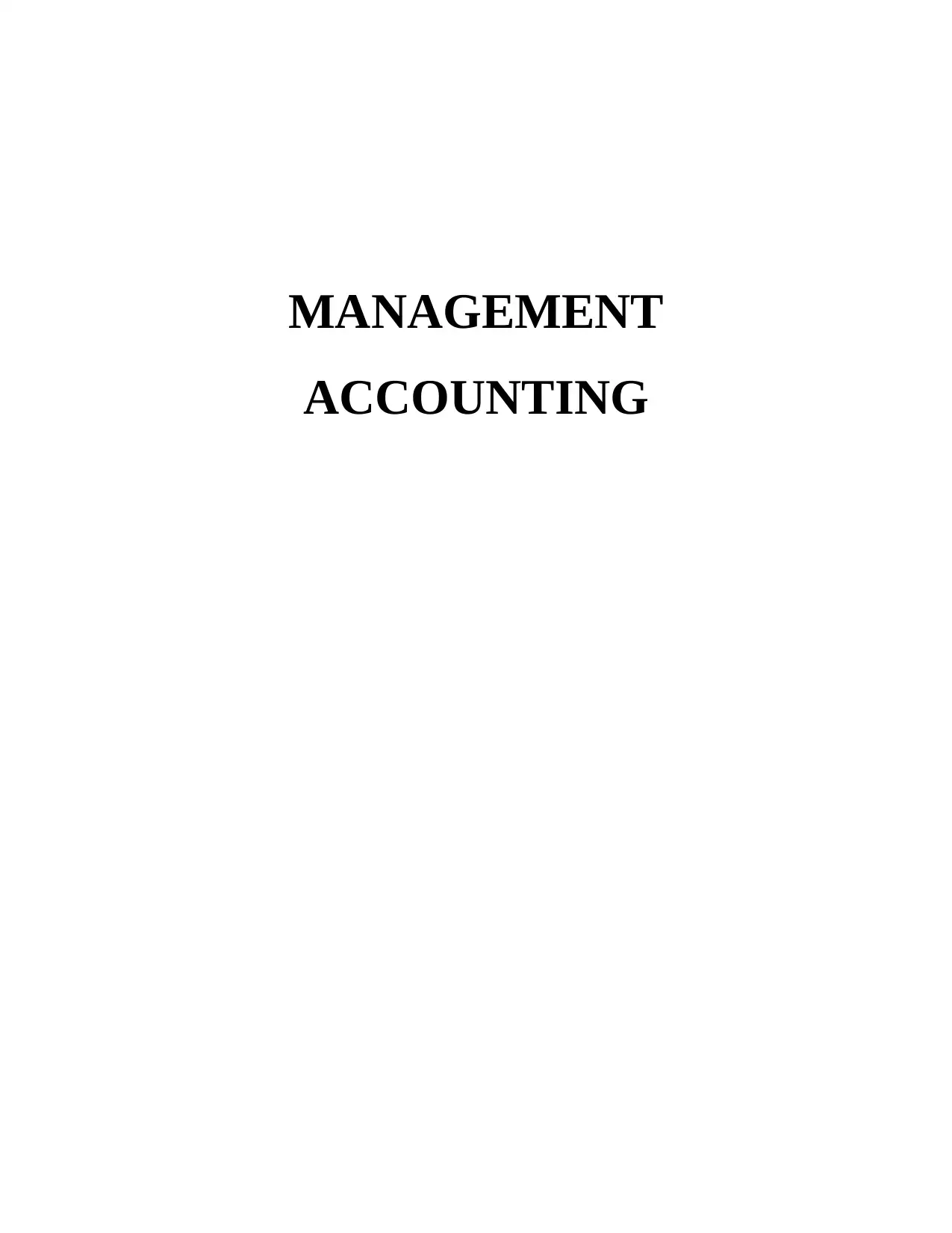
MANAGEMENT
ACCOUNTING
ACCOUNTING
Paraphrase This Document
Need a fresh take? Get an instant paraphrase of this document with our AI Paraphraser
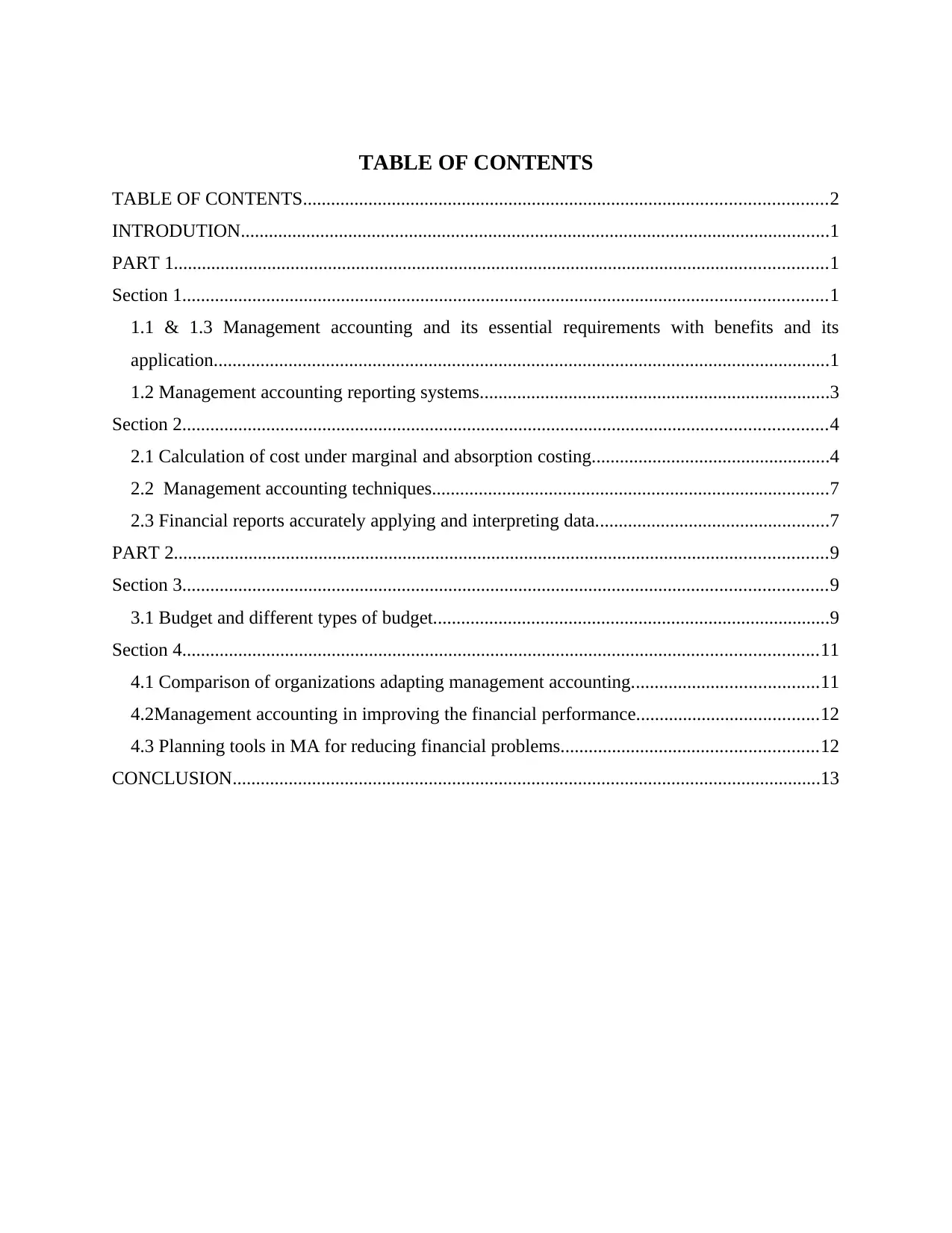
TABLE OF CONTENTS
TABLE OF CONTENTS................................................................................................................2
INTRODUTION..............................................................................................................................1
PART 1............................................................................................................................................1
Section 1..........................................................................................................................................1
1.1 & 1.3 Management accounting and its essential requirements with benefits and its
application....................................................................................................................................1
1.2 Management accounting reporting systems...........................................................................3
Section 2..........................................................................................................................................4
2.1 Calculation of cost under marginal and absorption costing...................................................4
2.2 Management accounting techniques.....................................................................................7
2.3 Financial reports accurately applying and interpreting data..................................................7
PART 2............................................................................................................................................9
Section 3..........................................................................................................................................9
3.1 Budget and different types of budget.....................................................................................9
Section 4........................................................................................................................................11
4.1 Comparison of organizations adapting management accounting........................................11
4.2Management accounting in improving the financial performance.......................................12
4.3 Planning tools in MA for reducing financial problems.......................................................12
CONCLUSION..............................................................................................................................13
TABLE OF CONTENTS................................................................................................................2
INTRODUTION..............................................................................................................................1
PART 1............................................................................................................................................1
Section 1..........................................................................................................................................1
1.1 & 1.3 Management accounting and its essential requirements with benefits and its
application....................................................................................................................................1
1.2 Management accounting reporting systems...........................................................................3
Section 2..........................................................................................................................................4
2.1 Calculation of cost under marginal and absorption costing...................................................4
2.2 Management accounting techniques.....................................................................................7
2.3 Financial reports accurately applying and interpreting data..................................................7
PART 2............................................................................................................................................9
Section 3..........................................................................................................................................9
3.1 Budget and different types of budget.....................................................................................9
Section 4........................................................................................................................................11
4.1 Comparison of organizations adapting management accounting........................................11
4.2Management accounting in improving the financial performance.......................................12
4.3 Planning tools in MA for reducing financial problems.......................................................12
CONCLUSION..............................................................................................................................13
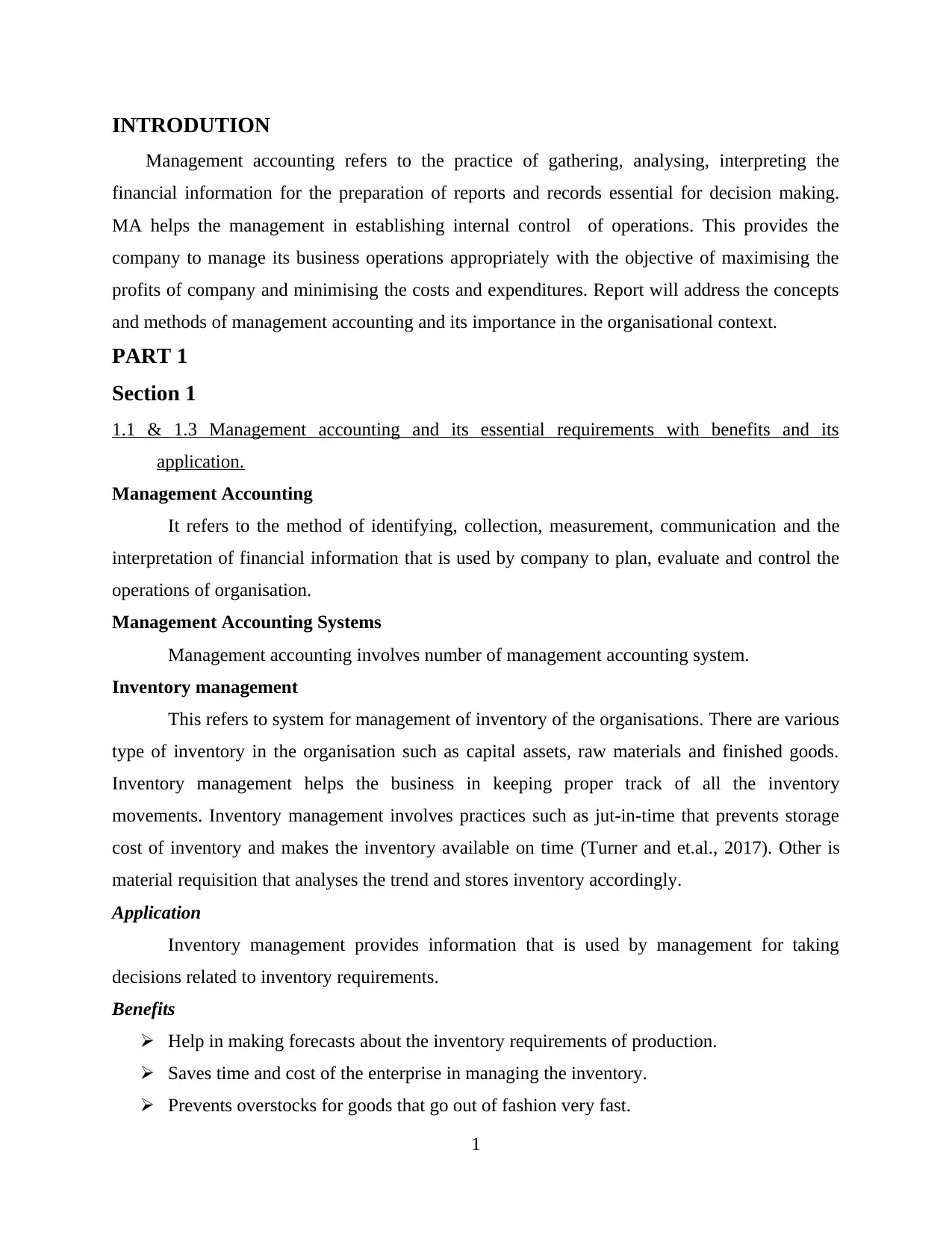
INTRODUTION
Management accounting refers to the practice of gathering, analysing, interpreting the
financial information for the preparation of reports and records essential for decision making.
MA helps the management in establishing internal control of operations. This provides the
company to manage its business operations appropriately with the objective of maximising the
profits of company and minimising the costs and expenditures. Report will address the concepts
and methods of management accounting and its importance in the organisational context.
PART 1
Section 1
1.1 & 1.3 Management accounting and its essential requirements with benefits and its
application.
Management Accounting
It refers to the method of identifying, collection, measurement, communication and the
interpretation of financial information that is used by company to plan, evaluate and control the
operations of organisation.
Management Accounting Systems
Management accounting involves number of management accounting system.
Inventory management
This refers to system for management of inventory of the organisations. There are various
type of inventory in the organisation such as capital assets, raw materials and finished goods.
Inventory management helps the business in keeping proper track of all the inventory
movements. Inventory management involves practices such as jut-in-time that prevents storage
cost of inventory and makes the inventory available on time (Turner and et.al., 2017). Other is
material requisition that analyses the trend and stores inventory accordingly.
Application
Inventory management provides information that is used by management for taking
decisions related to inventory requirements.
Benefits
Help in making forecasts about the inventory requirements of production.
Saves time and cost of the enterprise in managing the inventory.
Prevents overstocks for goods that go out of fashion very fast.
1
Management accounting refers to the practice of gathering, analysing, interpreting the
financial information for the preparation of reports and records essential for decision making.
MA helps the management in establishing internal control of operations. This provides the
company to manage its business operations appropriately with the objective of maximising the
profits of company and minimising the costs and expenditures. Report will address the concepts
and methods of management accounting and its importance in the organisational context.
PART 1
Section 1
1.1 & 1.3 Management accounting and its essential requirements with benefits and its
application.
Management Accounting
It refers to the method of identifying, collection, measurement, communication and the
interpretation of financial information that is used by company to plan, evaluate and control the
operations of organisation.
Management Accounting Systems
Management accounting involves number of management accounting system.
Inventory management
This refers to system for management of inventory of the organisations. There are various
type of inventory in the organisation such as capital assets, raw materials and finished goods.
Inventory management helps the business in keeping proper track of all the inventory
movements. Inventory management involves practices such as jut-in-time that prevents storage
cost of inventory and makes the inventory available on time (Turner and et.al., 2017). Other is
material requisition that analyses the trend and stores inventory accordingly.
Application
Inventory management provides information that is used by management for taking
decisions related to inventory requirements.
Benefits
Help in making forecasts about the inventory requirements of production.
Saves time and cost of the enterprise in managing the inventory.
Prevents overstocks for goods that go out of fashion very fast.
1
⊘ This is a preview!⊘
Do you want full access?
Subscribe today to unlock all pages.

Trusted by 1+ million students worldwide
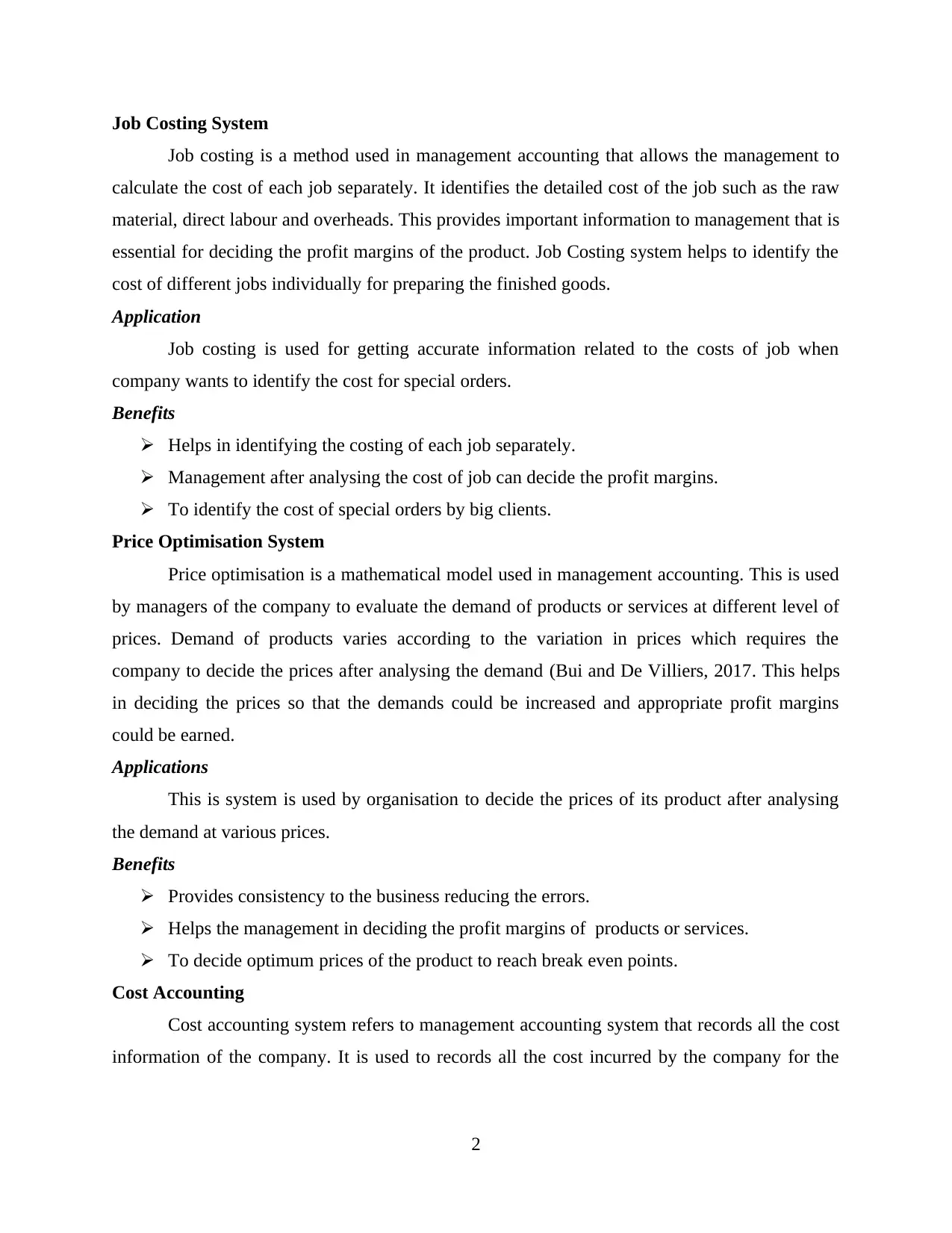
Job Costing System
Job costing is a method used in management accounting that allows the management to
calculate the cost of each job separately. It identifies the detailed cost of the job such as the raw
material, direct labour and overheads. This provides important information to management that is
essential for deciding the profit margins of the product. Job Costing system helps to identify the
cost of different jobs individually for preparing the finished goods.
Application
Job costing is used for getting accurate information related to the costs of job when
company wants to identify the cost for special orders.
Benefits
Helps in identifying the costing of each job separately.
Management after analysing the cost of job can decide the profit margins.
To identify the cost of special orders by big clients.
Price Optimisation System
Price optimisation is a mathematical model used in management accounting. This is used
by managers of the company to evaluate the demand of products or services at different level of
prices. Demand of products varies according to the variation in prices which requires the
company to decide the prices after analysing the demand (Bui and De Villiers, 2017. This helps
in deciding the prices so that the demands could be increased and appropriate profit margins
could be earned.
Applications
This is system is used by organisation to decide the prices of its product after analysing
the demand at various prices.
Benefits
Provides consistency to the business reducing the errors.
Helps the management in deciding the profit margins of products or services.
To decide optimum prices of the product to reach break even points.
Cost Accounting
Cost accounting system refers to management accounting system that records all the cost
information of the company. It is used to records all the cost incurred by the company for the
2
Job costing is a method used in management accounting that allows the management to
calculate the cost of each job separately. It identifies the detailed cost of the job such as the raw
material, direct labour and overheads. This provides important information to management that is
essential for deciding the profit margins of the product. Job Costing system helps to identify the
cost of different jobs individually for preparing the finished goods.
Application
Job costing is used for getting accurate information related to the costs of job when
company wants to identify the cost for special orders.
Benefits
Helps in identifying the costing of each job separately.
Management after analysing the cost of job can decide the profit margins.
To identify the cost of special orders by big clients.
Price Optimisation System
Price optimisation is a mathematical model used in management accounting. This is used
by managers of the company to evaluate the demand of products or services at different level of
prices. Demand of products varies according to the variation in prices which requires the
company to decide the prices after analysing the demand (Bui and De Villiers, 2017. This helps
in deciding the prices so that the demands could be increased and appropriate profit margins
could be earned.
Applications
This is system is used by organisation to decide the prices of its product after analysing
the demand at various prices.
Benefits
Provides consistency to the business reducing the errors.
Helps the management in deciding the profit margins of products or services.
To decide optimum prices of the product to reach break even points.
Cost Accounting
Cost accounting system refers to management accounting system that records all the cost
information of the company. It is used to records all the cost incurred by the company for the
2
Paraphrase This Document
Need a fresh take? Get an instant paraphrase of this document with our AI Paraphraser
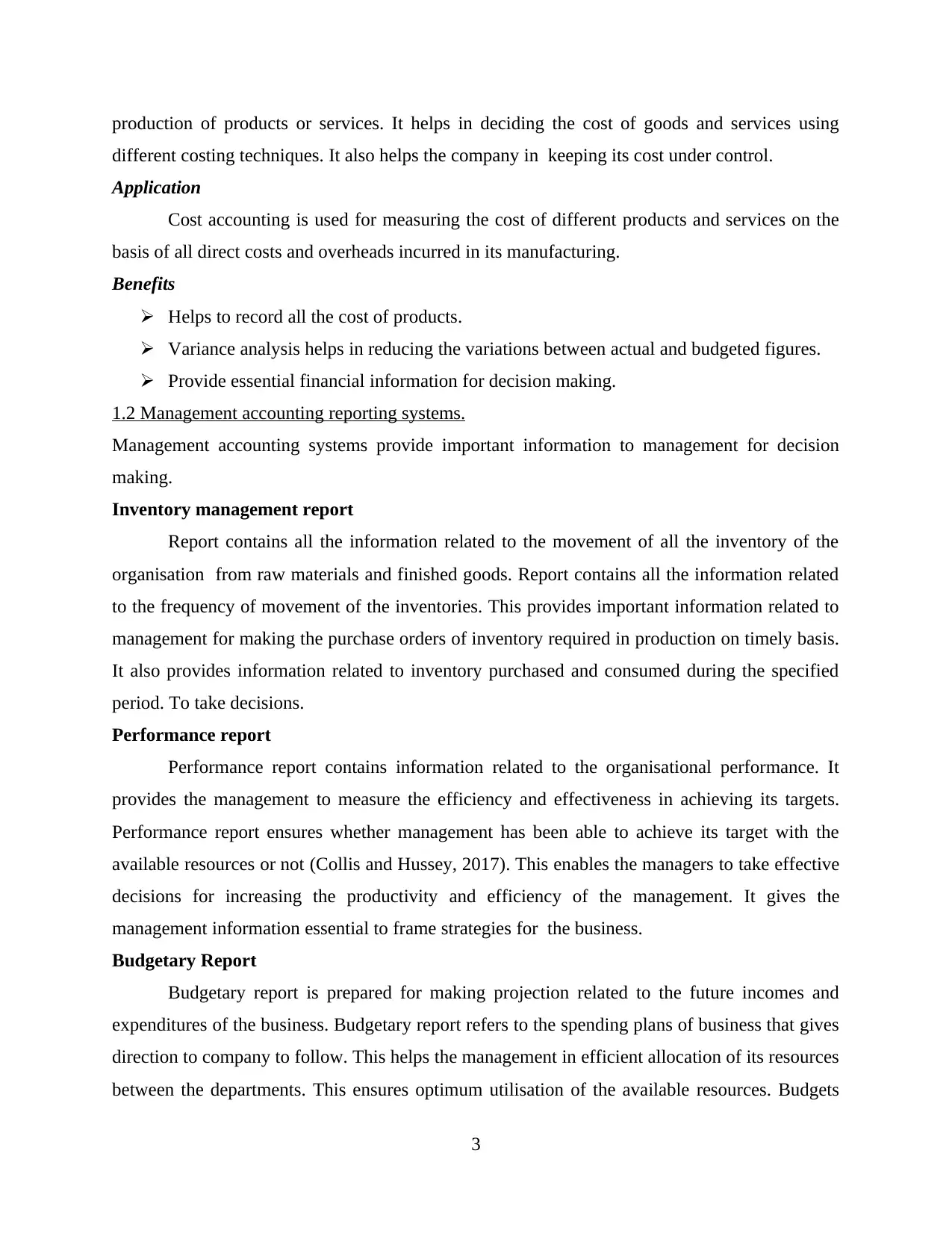
production of products or services. It helps in deciding the cost of goods and services using
different costing techniques. It also helps the company in keeping its cost under control.
Application
Cost accounting is used for measuring the cost of different products and services on the
basis of all direct costs and overheads incurred in its manufacturing.
Benefits
Helps to record all the cost of products.
Variance analysis helps in reducing the variations between actual and budgeted figures.
Provide essential financial information for decision making.
1.2 Management accounting reporting systems.
Management accounting systems provide important information to management for decision
making.
Inventory management report
Report contains all the information related to the movement of all the inventory of the
organisation from raw materials and finished goods. Report contains all the information related
to the frequency of movement of the inventories. This provides important information related to
management for making the purchase orders of inventory required in production on timely basis.
It also provides information related to inventory purchased and consumed during the specified
period. To take decisions.
Performance report
Performance report contains information related to the organisational performance. It
provides the management to measure the efficiency and effectiveness in achieving its targets.
Performance report ensures whether management has been able to achieve its target with the
available resources or not (Collis and Hussey, 2017). This enables the managers to take effective
decisions for increasing the productivity and efficiency of the management. It gives the
management information essential to frame strategies for the business.
Budgetary Report
Budgetary report is prepared for making projection related to the future incomes and
expenditures of the business. Budgetary report refers to the spending plans of business that gives
direction to company to follow. This helps the management in efficient allocation of its resources
between the departments. This ensures optimum utilisation of the available resources. Budgets
3
different costing techniques. It also helps the company in keeping its cost under control.
Application
Cost accounting is used for measuring the cost of different products and services on the
basis of all direct costs and overheads incurred in its manufacturing.
Benefits
Helps to record all the cost of products.
Variance analysis helps in reducing the variations between actual and budgeted figures.
Provide essential financial information for decision making.
1.2 Management accounting reporting systems.
Management accounting systems provide important information to management for decision
making.
Inventory management report
Report contains all the information related to the movement of all the inventory of the
organisation from raw materials and finished goods. Report contains all the information related
to the frequency of movement of the inventories. This provides important information related to
management for making the purchase orders of inventory required in production on timely basis.
It also provides information related to inventory purchased and consumed during the specified
period. To take decisions.
Performance report
Performance report contains information related to the organisational performance. It
provides the management to measure the efficiency and effectiveness in achieving its targets.
Performance report ensures whether management has been able to achieve its target with the
available resources or not (Collis and Hussey, 2017). This enables the managers to take effective
decisions for increasing the productivity and efficiency of the management. It gives the
management information essential to frame strategies for the business.
Budgetary Report
Budgetary report is prepared for making projection related to the future incomes and
expenditures of the business. Budgetary report refers to the spending plans of business that gives
direction to company to follow. This helps the management in efficient allocation of its resources
between the departments. This ensures optimum utilisation of the available resources. Budgets
3
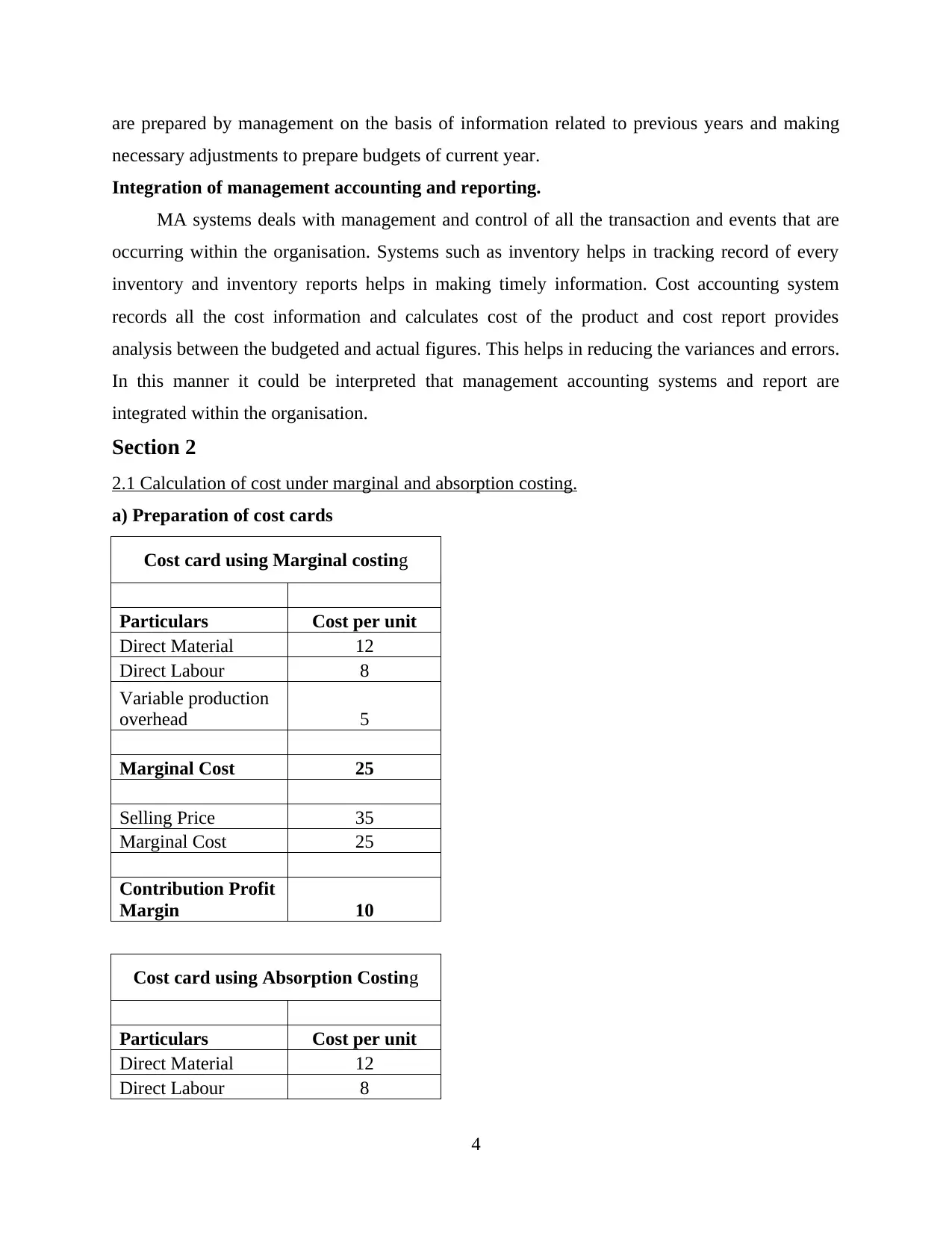
are prepared by management on the basis of information related to previous years and making
necessary adjustments to prepare budgets of current year.
Integration of management accounting and reporting.
MA systems deals with management and control of all the transaction and events that are
occurring within the organisation. Systems such as inventory helps in tracking record of every
inventory and inventory reports helps in making timely information. Cost accounting system
records all the cost information and calculates cost of the product and cost report provides
analysis between the budgeted and actual figures. This helps in reducing the variances and errors.
In this manner it could be interpreted that management accounting systems and report are
integrated within the organisation.
Section 2
2.1 Calculation of cost under marginal and absorption costing.
a) Preparation of cost cards
Cost card using Marginal costing
Particulars Cost per unit
Direct Material 12
Direct Labour 8
Variable production
overhead 5
Marginal Cost 25
Selling Price 35
Marginal Cost 25
Contribution Profit
Margin 10
Cost card using Absorption Costing
Particulars Cost per unit
Direct Material 12
Direct Labour 8
4
necessary adjustments to prepare budgets of current year.
Integration of management accounting and reporting.
MA systems deals with management and control of all the transaction and events that are
occurring within the organisation. Systems such as inventory helps in tracking record of every
inventory and inventory reports helps in making timely information. Cost accounting system
records all the cost information and calculates cost of the product and cost report provides
analysis between the budgeted and actual figures. This helps in reducing the variances and errors.
In this manner it could be interpreted that management accounting systems and report are
integrated within the organisation.
Section 2
2.1 Calculation of cost under marginal and absorption costing.
a) Preparation of cost cards
Cost card using Marginal costing
Particulars Cost per unit
Direct Material 12
Direct Labour 8
Variable production
overhead 5
Marginal Cost 25
Selling Price 35
Marginal Cost 25
Contribution Profit
Margin 10
Cost card using Absorption Costing
Particulars Cost per unit
Direct Material 12
Direct Labour 8
4
⊘ This is a preview!⊘
Do you want full access?
Subscribe today to unlock all pages.

Trusted by 1+ million students worldwide
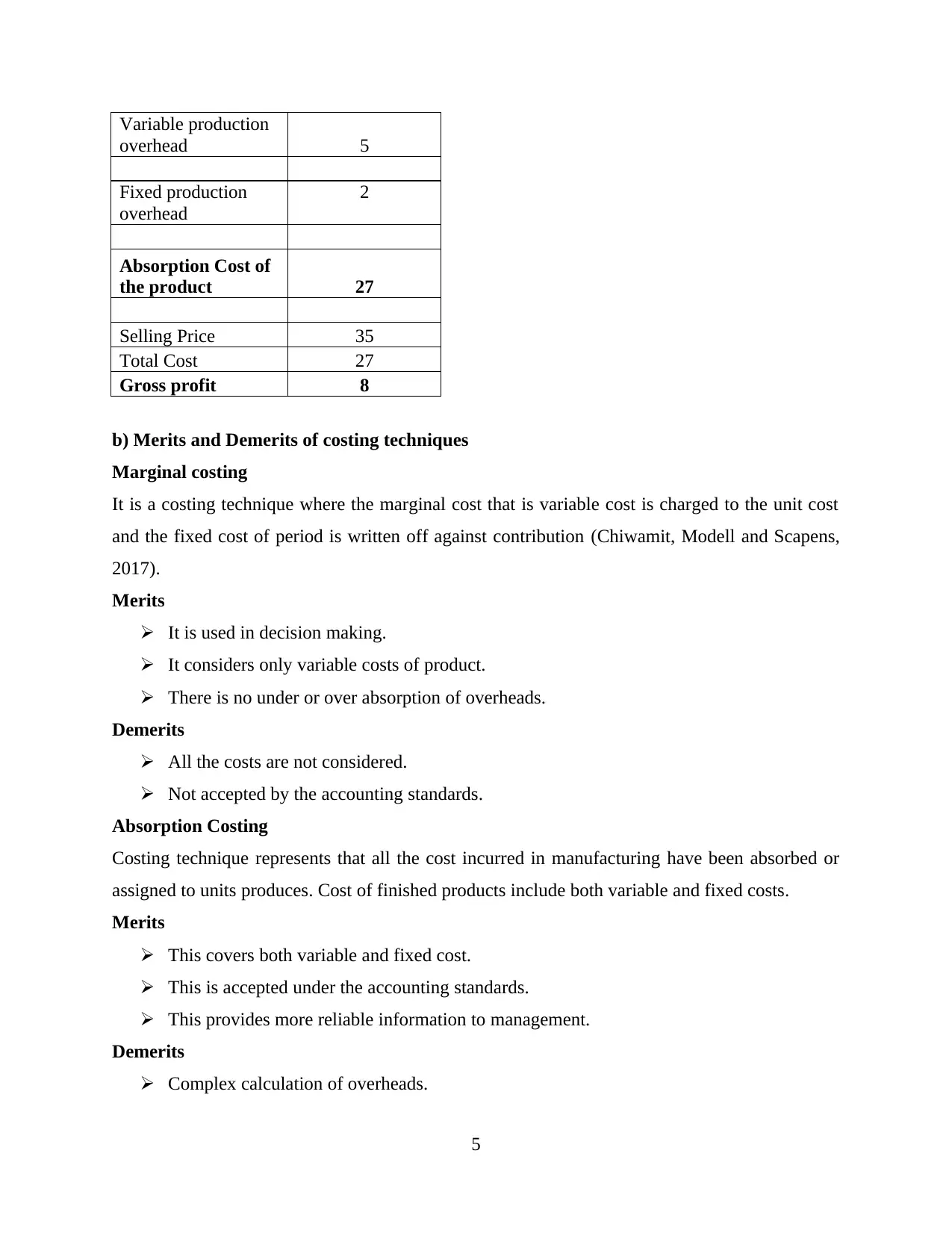
Variable production
overhead 5
Fixed production
overhead
2
Absorption Cost of
the product 27
Selling Price 35
Total Cost 27
Gross profit 8
b) Merits and Demerits of costing techniques
Marginal costing
It is a costing technique where the marginal cost that is variable cost is charged to the unit cost
and the fixed cost of period is written off against contribution (Chiwamit, Modell and Scapens,
2017).
Merits
It is used in decision making.
It considers only variable costs of product.
There is no under or over absorption of overheads.
Demerits
All the costs are not considered.
Not accepted by the accounting standards.
Absorption Costing
Costing technique represents that all the cost incurred in manufacturing have been absorbed or
assigned to units produces. Cost of finished products include both variable and fixed costs.
Merits
This covers both variable and fixed cost.
This is accepted under the accounting standards.
This provides more reliable information to management.
Demerits
Complex calculation of overheads.
5
overhead 5
Fixed production
overhead
2
Absorption Cost of
the product 27
Selling Price 35
Total Cost 27
Gross profit 8
b) Merits and Demerits of costing techniques
Marginal costing
It is a costing technique where the marginal cost that is variable cost is charged to the unit cost
and the fixed cost of period is written off against contribution (Chiwamit, Modell and Scapens,
2017).
Merits
It is used in decision making.
It considers only variable costs of product.
There is no under or over absorption of overheads.
Demerits
All the costs are not considered.
Not accepted by the accounting standards.
Absorption Costing
Costing technique represents that all the cost incurred in manufacturing have been absorbed or
assigned to units produces. Cost of finished products include both variable and fixed costs.
Merits
This covers both variable and fixed cost.
This is accepted under the accounting standards.
This provides more reliable information to management.
Demerits
Complex calculation of overheads.
5
Paraphrase This Document
Need a fresh take? Get an instant paraphrase of this document with our AI Paraphraser
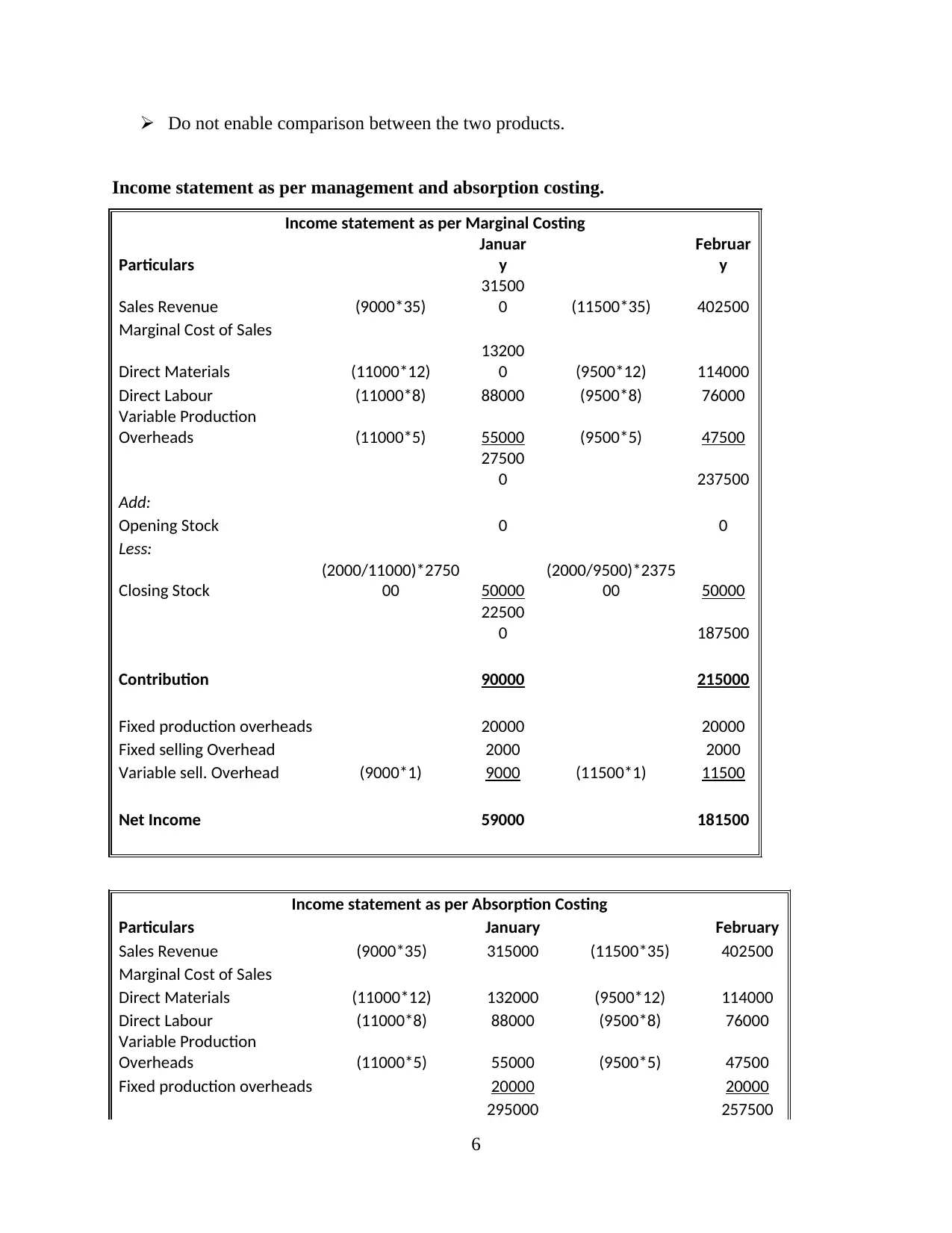
Do not enable comparison between the two products.
Income statement as per management and absorption costing.
Income statement as per Marginal Costing
Particulars
Januar
y
Februar
y
Sales Revenue (9000*35)
31500
0 (11500*35) 402500
Marginal Cost of Sales
Direct Materials (11000*12)
13200
0 (9500*12) 114000
Direct Labour (11000*8) 88000 (9500*8) 76000
Variable Production
Overheads (11000*5) 55000 (9500*5) 47500
27500
0 237500
Add:
Opening Stock 0 0
Less:
Closing Stock
(2000/11000)*2750
00 50000
(2000/9500)*2375
00 50000
22500
0 187500
Contribution 90000 215000
Fixed production overheads 20000 20000
Fixed selling Overhead 2000 2000
Variable sell. Overhead (9000*1) 9000 (11500*1) 11500
Net Income 59000 181500
Income statement as per Absorption Costing
Particulars January February
Sales Revenue (9000*35) 315000 (11500*35) 402500
Marginal Cost of Sales
Direct Materials (11000*12) 132000 (9500*12) 114000
Direct Labour (11000*8) 88000 (9500*8) 76000
Variable Production
Overheads (11000*5) 55000 (9500*5) 47500
Fixed production overheads 20000 20000
295000 257500
6
Income statement as per management and absorption costing.
Income statement as per Marginal Costing
Particulars
Januar
y
Februar
y
Sales Revenue (9000*35)
31500
0 (11500*35) 402500
Marginal Cost of Sales
Direct Materials (11000*12)
13200
0 (9500*12) 114000
Direct Labour (11000*8) 88000 (9500*8) 76000
Variable Production
Overheads (11000*5) 55000 (9500*5) 47500
27500
0 237500
Add:
Opening Stock 0 0
Less:
Closing Stock
(2000/11000)*2750
00 50000
(2000/9500)*2375
00 50000
22500
0 187500
Contribution 90000 215000
Fixed production overheads 20000 20000
Fixed selling Overhead 2000 2000
Variable sell. Overhead (9000*1) 9000 (11500*1) 11500
Net Income 59000 181500
Income statement as per Absorption Costing
Particulars January February
Sales Revenue (9000*35) 315000 (11500*35) 402500
Marginal Cost of Sales
Direct Materials (11000*12) 132000 (9500*12) 114000
Direct Labour (11000*8) 88000 (9500*8) 76000
Variable Production
Overheads (11000*5) 55000 (9500*5) 47500
Fixed production overheads 20000 20000
295000 257500
6
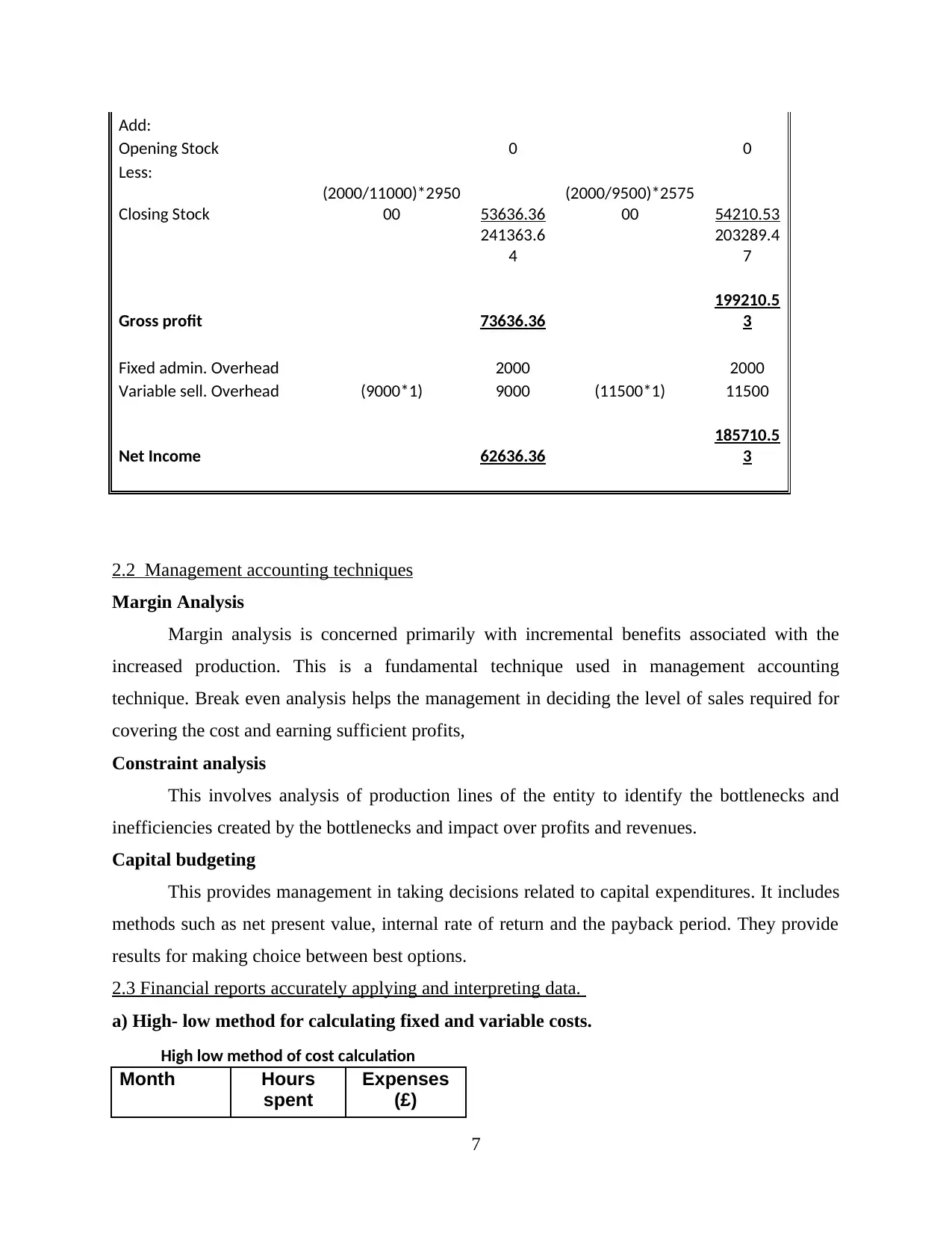
Add:
Opening Stock 0 0
Less:
Closing Stock
(2000/11000)*2950
00 53636.36
(2000/9500)*2575
00 54210.53
241363.6
4
203289.4
7
Gross profit 73636.36
199210.5
3
Fixed admin. Overhead 2000 2000
Variable sell. Overhead (9000*1) 9000 (11500*1) 11500
Net Income 62636.36
185710.5
3
2.2 Management accounting techniques
Margin Analysis
Margin analysis is concerned primarily with incremental benefits associated with the
increased production. This is a fundamental technique used in management accounting
technique. Break even analysis helps the management in deciding the level of sales required for
covering the cost and earning sufficient profits,
Constraint analysis
This involves analysis of production lines of the entity to identify the bottlenecks and
inefficiencies created by the bottlenecks and impact over profits and revenues.
Capital budgeting
This provides management in taking decisions related to capital expenditures. It includes
methods such as net present value, internal rate of return and the payback period. They provide
results for making choice between best options.
2.3 Financial reports accurately applying and interpreting data.
a) High- low method for calculating fixed and variable costs.
High low method of cost calculation
Month Hours
spent
Expenses
(£)
7
Opening Stock 0 0
Less:
Closing Stock
(2000/11000)*2950
00 53636.36
(2000/9500)*2575
00 54210.53
241363.6
4
203289.4
7
Gross profit 73636.36
199210.5
3
Fixed admin. Overhead 2000 2000
Variable sell. Overhead (9000*1) 9000 (11500*1) 11500
Net Income 62636.36
185710.5
3
2.2 Management accounting techniques
Margin Analysis
Margin analysis is concerned primarily with incremental benefits associated with the
increased production. This is a fundamental technique used in management accounting
technique. Break even analysis helps the management in deciding the level of sales required for
covering the cost and earning sufficient profits,
Constraint analysis
This involves analysis of production lines of the entity to identify the bottlenecks and
inefficiencies created by the bottlenecks and impact over profits and revenues.
Capital budgeting
This provides management in taking decisions related to capital expenditures. It includes
methods such as net present value, internal rate of return and the payback period. They provide
results for making choice between best options.
2.3 Financial reports accurately applying and interpreting data.
a) High- low method for calculating fixed and variable costs.
High low method of cost calculation
Month Hours
spent
Expenses
(£)
7
⊘ This is a preview!⊘
Do you want full access?
Subscribe today to unlock all pages.

Trusted by 1+ million students worldwide
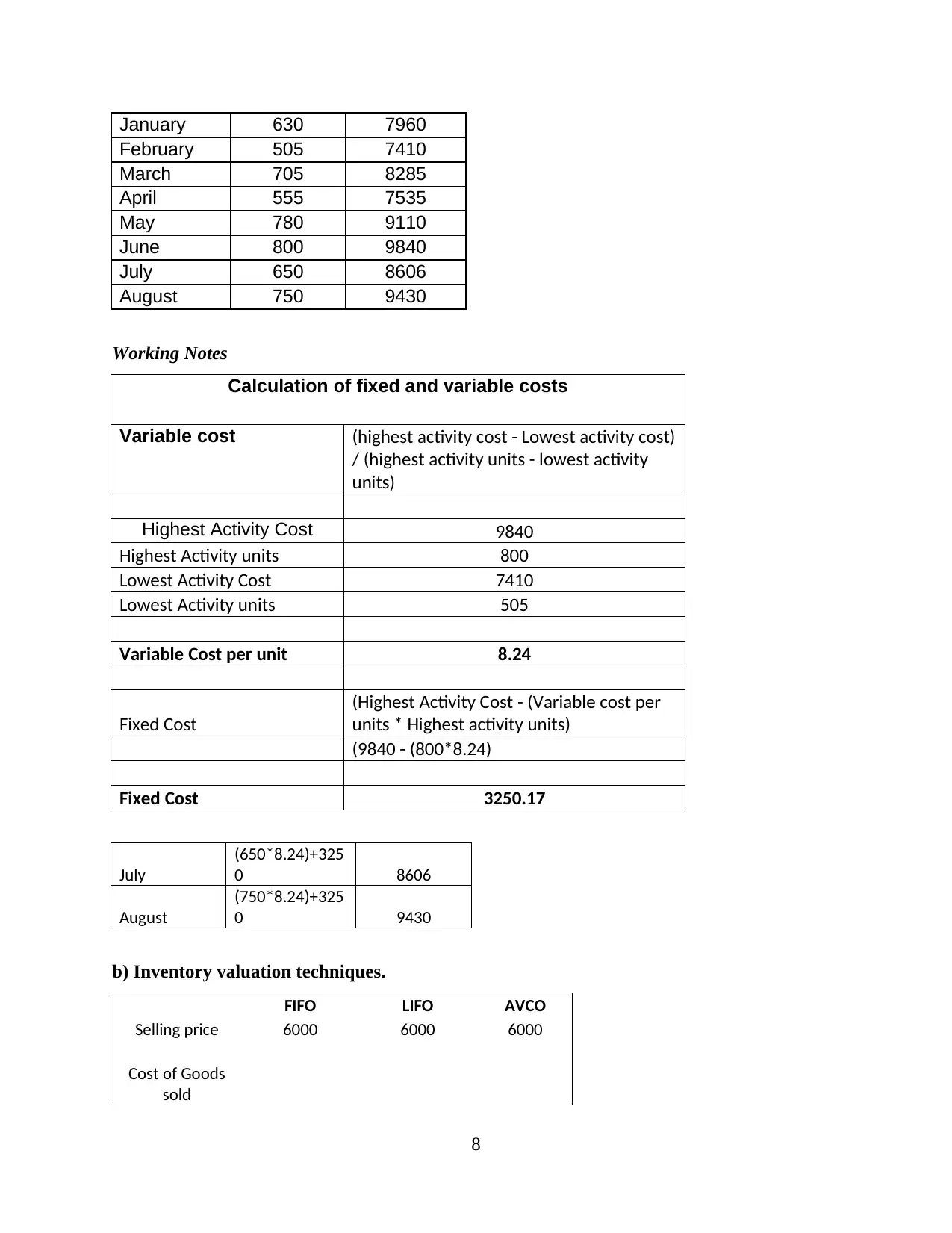
January 630 7960
February 505 7410
March 705 8285
April 555 7535
May 780 9110
June 800 9840
July 650 8606
August 750 9430
Working Notes
Calculation of fixed and variable costs
Variable cost (highest activity cost - Lowest activity cost)
/ (highest activity units - lowest activity
units)
Highest Activity Cost 9840
Highest Activity units 800
Lowest Activity Cost 7410
Lowest Activity units 505
Variable Cost per unit 8.24
Fixed Cost
(Highest Activity Cost - (Variable cost per
units * Highest activity units)
(9840 - (800*8.24)
Fixed Cost 3250.17
July
(650*8.24)+325
0 8606
August
(750*8.24)+325
0 9430
b) Inventory valuation techniques.
FIFO LIFO AVCO
Selling price 6000 6000 6000
Cost of Goods
sold
8
February 505 7410
March 705 8285
April 555 7535
May 780 9110
June 800 9840
July 650 8606
August 750 9430
Working Notes
Calculation of fixed and variable costs
Variable cost (highest activity cost - Lowest activity cost)
/ (highest activity units - lowest activity
units)
Highest Activity Cost 9840
Highest Activity units 800
Lowest Activity Cost 7410
Lowest Activity units 505
Variable Cost per unit 8.24
Fixed Cost
(Highest Activity Cost - (Variable cost per
units * Highest activity units)
(9840 - (800*8.24)
Fixed Cost 3250.17
July
(650*8.24)+325
0 8606
August
(750*8.24)+325
0 9430
b) Inventory valuation techniques.
FIFO LIFO AVCO
Selling price 6000 6000 6000
Cost of Goods
sold
8
Paraphrase This Document
Need a fresh take? Get an instant paraphrase of this document with our AI Paraphraser
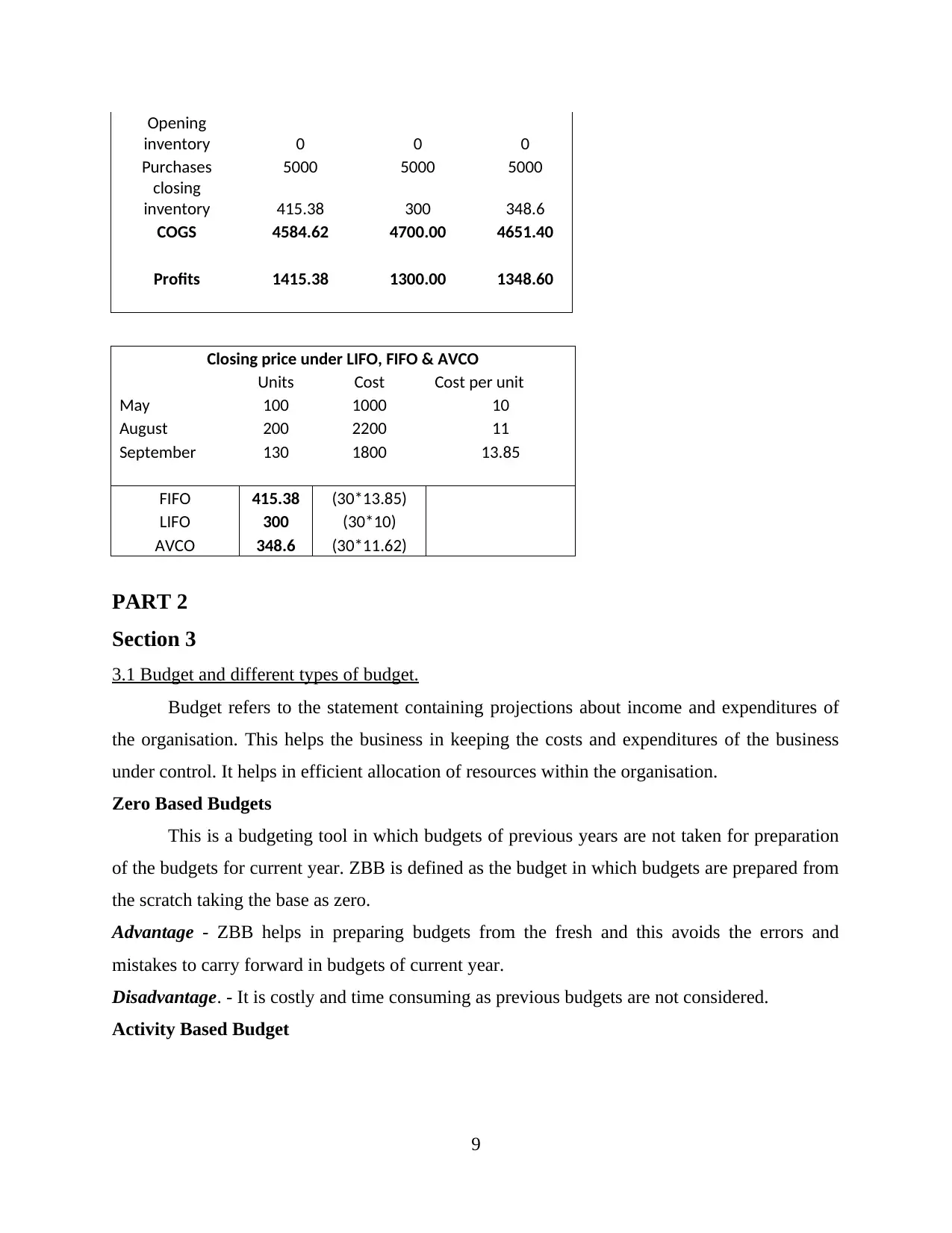
Opening
inventory 0 0 0
Purchases 5000 5000 5000
closing
inventory 415.38 300 348.6
COGS 4584.62 4700.00 4651.40
Profits 1415.38 1300.00 1348.60
Closing price under LIFO, FIFO & AVCO
Units Cost Cost per unit
May 100 1000 10
August 200 2200 11
September 130 1800 13.85
FIFO 415.38 (30*13.85)
LIFO 300 (30*10)
AVCO 348.6 (30*11.62)
PART 2
Section 3
3.1 Budget and different types of budget.
Budget refers to the statement containing projections about income and expenditures of
the organisation. This helps the business in keeping the costs and expenditures of the business
under control. It helps in efficient allocation of resources within the organisation.
Zero Based Budgets
This is a budgeting tool in which budgets of previous years are not taken for preparation
of the budgets for current year. ZBB is defined as the budget in which budgets are prepared from
the scratch taking the base as zero.
Advantage - ZBB helps in preparing budgets from the fresh and this avoids the errors and
mistakes to carry forward in budgets of current year.
Disadvantage. - It is costly and time consuming as previous budgets are not considered.
Activity Based Budget
9
inventory 0 0 0
Purchases 5000 5000 5000
closing
inventory 415.38 300 348.6
COGS 4584.62 4700.00 4651.40
Profits 1415.38 1300.00 1348.60
Closing price under LIFO, FIFO & AVCO
Units Cost Cost per unit
May 100 1000 10
August 200 2200 11
September 130 1800 13.85
FIFO 415.38 (30*13.85)
LIFO 300 (30*10)
AVCO 348.6 (30*11.62)
PART 2
Section 3
3.1 Budget and different types of budget.
Budget refers to the statement containing projections about income and expenditures of
the organisation. This helps the business in keeping the costs and expenditures of the business
under control. It helps in efficient allocation of resources within the organisation.
Zero Based Budgets
This is a budgeting tool in which budgets of previous years are not taken for preparation
of the budgets for current year. ZBB is defined as the budget in which budgets are prepared from
the scratch taking the base as zero.
Advantage - ZBB helps in preparing budgets from the fresh and this avoids the errors and
mistakes to carry forward in budgets of current year.
Disadvantage. - It is costly and time consuming as previous budgets are not considered.
Activity Based Budget
9
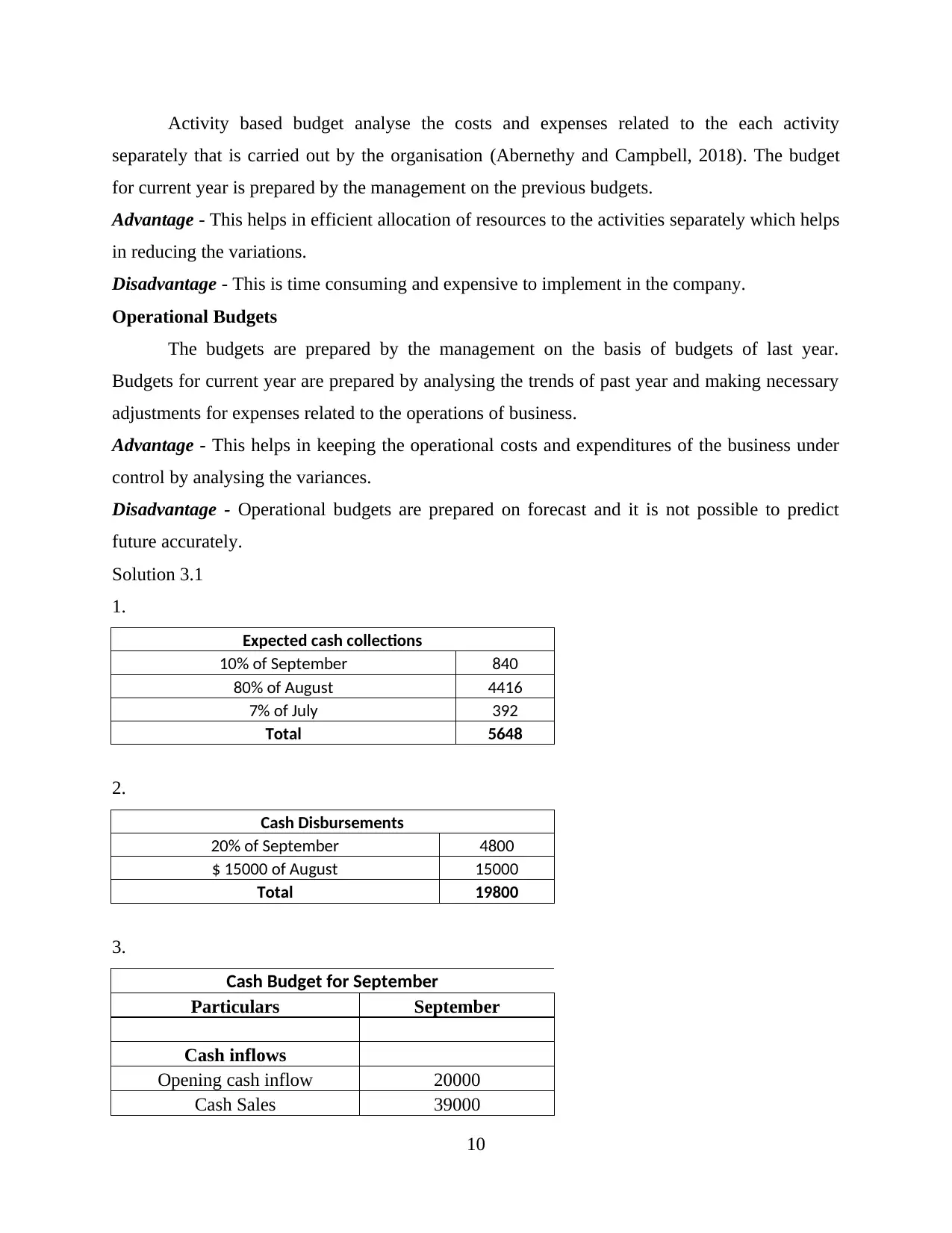
Activity based budget analyse the costs and expenses related to the each activity
separately that is carried out by the organisation (Abernethy and Campbell, 2018). The budget
for current year is prepared by the management on the previous budgets.
Advantage - This helps in efficient allocation of resources to the activities separately which helps
in reducing the variations.
Disadvantage - This is time consuming and expensive to implement in the company.
Operational Budgets
The budgets are prepared by the management on the basis of budgets of last year.
Budgets for current year are prepared by analysing the trends of past year and making necessary
adjustments for expenses related to the operations of business.
Advantage - This helps in keeping the operational costs and expenditures of the business under
control by analysing the variances.
Disadvantage - Operational budgets are prepared on forecast and it is not possible to predict
future accurately.
Solution 3.1
1.
Expected cash collections
10% of September 840
80% of August 4416
7% of July 392
Total 5648
2.
Cash Disbursements
20% of September 4800
$ 15000 of August 15000
Total 19800
3.
Cash Budget for September
Particulars September
Cash inflows
Opening cash inflow 20000
Cash Sales 39000
10
separately that is carried out by the organisation (Abernethy and Campbell, 2018). The budget
for current year is prepared by the management on the previous budgets.
Advantage - This helps in efficient allocation of resources to the activities separately which helps
in reducing the variations.
Disadvantage - This is time consuming and expensive to implement in the company.
Operational Budgets
The budgets are prepared by the management on the basis of budgets of last year.
Budgets for current year are prepared by analysing the trends of past year and making necessary
adjustments for expenses related to the operations of business.
Advantage - This helps in keeping the operational costs and expenditures of the business under
control by analysing the variances.
Disadvantage - Operational budgets are prepared on forecast and it is not possible to predict
future accurately.
Solution 3.1
1.
Expected cash collections
10% of September 840
80% of August 4416
7% of July 392
Total 5648
2.
Cash Disbursements
20% of September 4800
$ 15000 of August 15000
Total 19800
3.
Cash Budget for September
Particulars September
Cash inflows
Opening cash inflow 20000
Cash Sales 39000
10
⊘ This is a preview!⊘
Do you want full access?
Subscribe today to unlock all pages.

Trusted by 1+ million students worldwide
1 out of 16
Related Documents
Your All-in-One AI-Powered Toolkit for Academic Success.
+13062052269
info@desklib.com
Available 24*7 on WhatsApp / Email
![[object Object]](/_next/static/media/star-bottom.7253800d.svg)
Unlock your academic potential
Copyright © 2020–2025 A2Z Services. All Rights Reserved. Developed and managed by ZUCOL.





